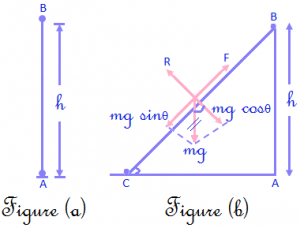Conservative Force: A force is said to be conservative if the work done by the force (or against the force) in moving a body depends only upon the initial and final positions of the body and is independent of the path followed between the initial and final positions.
The gravitational force is a conservative force. To prove this, let us calculate the work done against the gravitational force in raising a body of mass m through a height h from its initial position A to a final position B.
In Fig (a) the body is being raised vertically upwards. Hence the work done against the gravitational force mg is W = force * displacement = mgh
W = force * displacement = mgh
In Fig (b) the body is taken along a smooth inclined plane CB of height AB = h, and inclination θ. The force F required against gravity is equal to mg sinθ and the distance moved in the direction of force is CB. Hence, the work done is
W = F * CB
\(=m~g~sin\theta ~\left( \frac{h}{sin\theta } \right)=m~g~h\)
Thus the work done in moving a body against gravity depends only on the initial and final positions of the body, and not upon the path followed. Hence gravitational force is a conservative force. Other examples of conservative forces are elastic force, electrostatic force and magnetic force.
An important property of conservative forces is that the work done by a conservative force in moving a body through a complete round trip is zero.
Non conservative Forces: A force is said to be non-conservative, if the work done by the force, or against the force, in moving a body from one position to another, depends upon the path followed between the two positions.
The best example for the non-conservative force is friction. For suppose body is moving from A to B against the friction, then it have to spend some energy to overcome it in the return journey i, e from B to A also it has to overcome friction and spend the energy against it. Thus the work done in the entire process is not equal to 0. So we can say that frictional force is a non-conservative force
An example of non-conservative force is induction force acting on an electron in a betatron. After each round trip, the electron returns with more kinetic energy than what it had initially.
